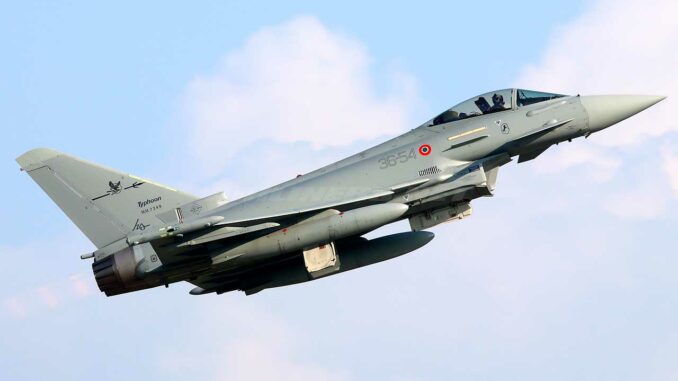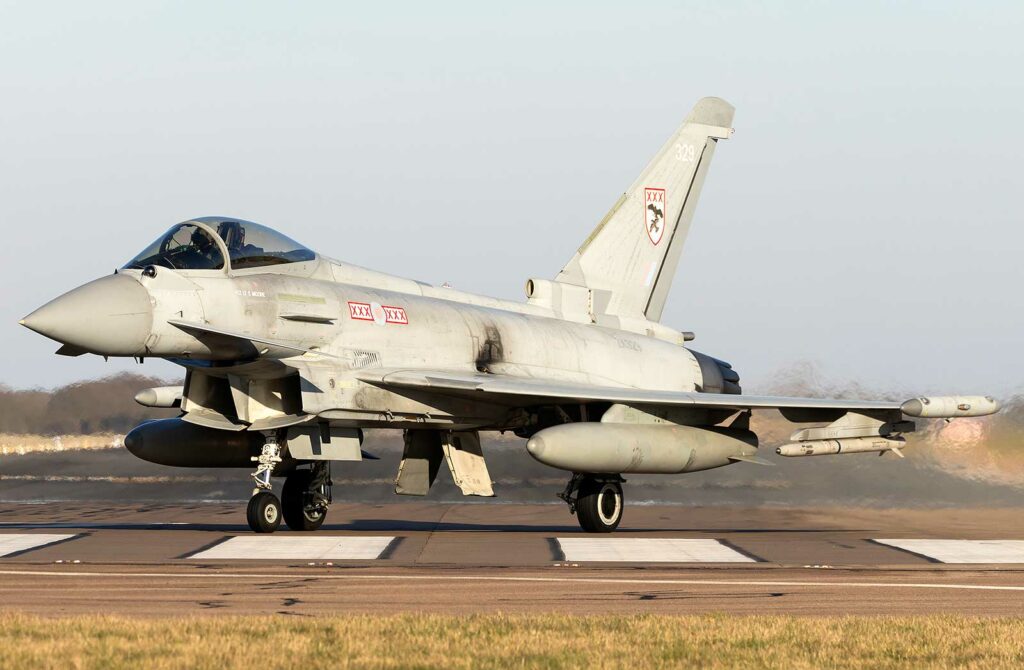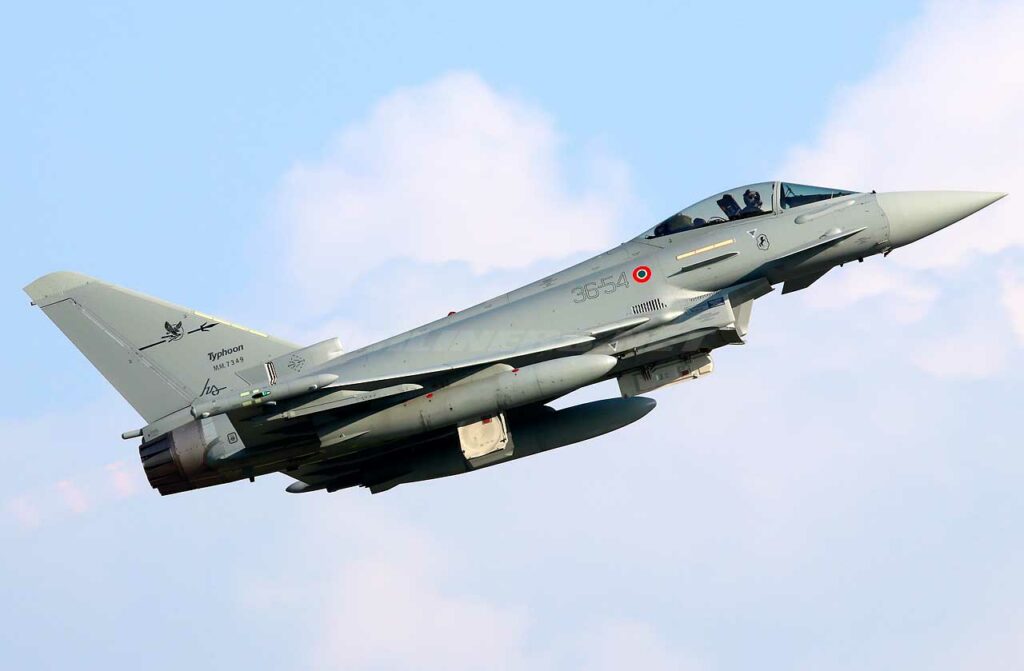
Eurofighter is increasing its production rate from 14 to 20 aircraft per year, up to 30 depending on orders, to meet increased NATO demand.
The Eurofighter consortium, a major European industrial player, announced on June 22, 2025, that it was increasing its annual production capacity for the Eurofighter Typhoon fighter aircraft from 14 to 20 aircraft, with a possible increase to 30 units if orders progress. This move comes at a time of growing tension and responds to acute demand from NATO to strengthen its air forces. For the first time in a long time, interest in fourth-generation combat aircraft is growing significantly, both among partner countries and in export markets. The consortium’s strategic initiative aims to secure value chains and preserve European industrial competitiveness in the face of US supremacy, embodied in particular by the F-35.
The strategic context and European demand
Renewed interest driven by geopolitical developments
The decision to increase production of the Eurofighter Typhoon comes at a tense time, marked by the war in Ukraine, growing hostility between NATO and Russia, and instability in the Middle East. Faced with these threats, several NATO member states wish to strengthen their air superiority, particularly on the eastern flank. The needs expressed are for around 60 fighter jets per year at the European level, while current capacity does not exceed 14 to 20 units. This limitation creates a gap between strategic air force planning and actual industrial capabilities.
A gradual increase in production to 20 or even 30 aircraft per year would secure fleet renewals while meeting operational requirements for air defense, deterrence, and rapid response. In particular, NATO’s rapid reaction forces (NATO Response Force) require modern, reliable and available resources in large numbers. As a multi-role air superiority fighter aircraft, the Typhoon remains a strategic platform that complements fifth-generation aircraft such as the F-35.
Renewal of national fleets
Recent orders confirm this momentum. Germany has added 20 aircraft to its Quadriga order of 38 units in 2024. Italy has acquired 24 aircraft for approximately $7.5 billion, while Spain, through the Halcón program, plans 45 deliveries by 2035. These commitments ensure the industrial continuity of the Eurofighter program until at least 2030.

Industrial and technological challenges
Adaptation of the production line
The increase in the production rate of the Eurofighter Typhoon from 14 to 20 units per year requires technical and logistical reorganization within the consortium. The consortium comprises Airbus Defence and Space (Germany, Spain), BAE Systems (United Kingdom) and Leonardo (Italy). According to Jorge Degenhardt, CEO of Eurofighter GmbH, the ramp-up will be achieved within three years. The maximum capacity target, assuming an expanded order book, is 30 fighter aircraft per year. This will require fine-tuning of the assembly lines, the subcontractor network and human resources.
Currently, the cycle between the signing of a contract and the final delivery of a Typhoon is around 50 months. This timeframe limits the program’s strategic responsiveness to military crises. The stated objective is to reduce this timeframe, in particular by simplifying certain industrial procedures and anticipating the management of critical components. Synchronization between the production lines in Getafe, Manching, Warton, and Turin is becoming a key issue. Any increase in production will also require rapid upskilling of technical staff, particularly on the final assembly lines.
Gradual modernization
In parallel with the quantitative increase, the consortium is continuing to modernize the Typhoon’s technology. The mid-life upgrade program (MLU) aims to strengthen the European fighter’s competitiveness. The United Kingdom is providing £204.6 million in funding for the integration of the new ECRS Mk2 radar, capable of operating in advanced electronic warfare mode. This version, expected at the end of 2025, will provide the Typhoon with enhanced jamming, multiband tracking and long-range detection capabilities.
Other developments include compatibility with buddy wingman drones and latest-generation smart munitions. These upgrades are designed to keep the Eurofighter Typhoon in the high-operational-value tactical fighter category until 2040.
Export opportunities and global market
International contract prospects
The Eurofighter consortium is actively pursuing exports to stabilize production beyond 2030. Several countries are among its strategic commercial targets: Austria, Saudi Arabia, Turkey, Poland, as well as countries in Latin America and Southeast Asia. The goal is clear: to secure 150 to 200 additional sales by the end of 2025, according to internal projections reported by Breaking Defense. PwC is even more optimistic, predicting 287 units sold, including 213 for export.
Among the campaigns currently underway, Saudi Arabia is a key target. Riyadh could order up to 60 Eurofighter Typhoons to supplement its current fleet acquired under the Al Salam agreement. However, this politically sensitive contract is facing opposition from Germany, which is maintaining its veto on human rights grounds. For its part, Turkey has expressed interest in 40 aircraft, half of which would be second-hand and half new (Tranche 4), against a backdrop of tensions with the United States over access to the F-35. Here again, Berlin is blocking the deal for geopolitical reasons.
Other negotiations are underway in Central Europe. Poland, which is engaged in a modernization race, could be a future customer, especially if it diversifies away from the F-35. The Typhoon export program is therefore closely linked to intra-European diplomatic power relations and the strategic autonomy sought by certain states.
A credible competitor to US systems
On the global fighter jet market, the Eurofighter Typhoon is positioned as a tangible alternative to Lockheed Martin’s F-35. This differentiation is based on two levers: industrial sovereignty and technological independence. Several countries reluctant to integrate into the US surveillance ecosystem see the Typhoon as a freer choice. For example, countries wishing to avoid the imposition of the F-35’s ALIS (Autonomic Logistics Information System) — considered a form of digital dependency — favor Western fourth-generation aircraft such as the Typhoon, the Rafale, or the Gripen E.
In the event of political tensions or embargoes, the Typhoon also offers a fully controlled European supply chain. This is a strategic advantage for countries such as Saudi Arabia, the United Arab Emirates, and even Indonesia, which are keen to avoid any interruption in operational support.
Although not stealthy, the Typhoon maintains high performance: a maximum speed close to Mach 2, maneuverability optimized by a digitally assisted unstable airframe, and multi-role capability (interception, ground attack, reconnaissance). This versatility, combined with continuous upgrades (AESA radar, electronic warfare, drone compatibility), allows it to remain competitive in a market dominated by American offerings.
Challenges and constraints
Sensitive political obstacles
The Eurofighter Typhoon program is governed by a principle of unanimity among the four nations in the consortium: Germany, the United Kingdom, Italy, and Spain. This co-management model, while ensuring industrial balance, leads to recurring export blockages. Each country has a veto right over foreign sales, which weakens the consortium’s ability to quickly conclude export contracts.
The case of Turkey is a concrete example. In April 2025, Berlin officially vetoed the sale of 40 Typhoons to Ankara, citing geopolitical considerations related to tensions with Greece and human rights violations. This deadlock immediately suspended negotiations, despite active support from London, Rome, and Madrid. In this context, the unanimity rule slows down the commercial strategy and puts Eurofighter at a competitive disadvantage compared to its US competitors, which benefit from a centralized decision-making chain.
The bureaucratic complexity of the consortium also hinders commercial responsiveness to more flexible offers from Lockheed Martin and Dassault Aviation. Potential buyers are sometimes reluctant to enter into negotiations that are subject to internal political reversals. A reform of export governance, or at the very least a clarification of diplomatic red lines, appears necessary if the Eurofighter is to secure its markets outside Europe in the long term.
Skills and industrial capacity
The stated goal of producing 30 Eurofighter fighter jets per year requires strengthening the consortium’s human and technical resources. One of the critical issues is the Warton plant in the United Kingdom, which accounts for a large part of the final assembly. This site employs nearly 6,000 people. Without new orders, its medium-term future is threatened, as is the preservation of the British expertise that is essential to the GCAP (Global Combat Air Program).
The ramp-up requires not only securing orders, but also continuous training for technicians, welders, embedded systems engineers, and composite materials specialists. However, these skills are rare and in high demand in other industrial sectors. The brain drain to other industries (space, civil, cybersecurity) is a reality. The consortium partners must therefore agree on a plan to secure critical skills by strengthening initial training and intergenerational transfer.
Finally, expanding production volume requires smooth coordination between the sites in Warton, Getafe, Manching, and Turin. Any delay at one of the centers can throw the entire process out of sync. In the absence of forward planning for the supply chains or in the event of tensions in the supply of strategic components (titanium, electronic components), the target of 30 units per year could quickly become unachievable.

Forward-looking scenarios and outlook for 2030
Long-term maintenance of production
The firm orders recorded by the Eurofighter consortium guarantee that the Typhoon production line will continue until 2030. Germany, Italy, and Spain have all signed contracts for deliveries spread over the second half of the decade. This stability allows the sites in Warton, Manching, Getafe, and Turin to plan their industrial workloads and consolidate employment. The announced ramp-up (20 to 30 aircraft per year) will strengthen the European industrial base and limit dependence on external programs.
Transition to future programs
In the medium term, the Eurofighter Typhoon will serve as an industrial and technological bridge to sixth-generation fighters, notably the GCAP (led by the United Kingdom, Italy, and Japan) and the FCAS (France, Germany, and Spain). These future combat aircraft are expected to be ready in 2035–2040, with operational service scheduled to begin around 2045. Until then, the Typhoon will continue to evolve (radars, electronic warfare, interoperability with drones), while maintaining critical skills and infrastructure. This transitional platform role is essential to avoid a capability gap between two technological generations. The Typhoon thus remains a tactical and industrial pillar at the European level.
The increase from 14 to 20 aircraft per year, with the possibility of increasing to 30 in the event of additional orders, demonstrates a conscious response to global tensions and NATO commitments. This move secures industrial interests, strengthens Europe’s fourth-generation air offering, and initiates the technological transition to next-generation programs. However, political, industrial, and financial challenges remain significant. Success will depend on the balance between operational orders, political stability among partners, and anticipation of future innovations.
War Wings Daily is an independant magazine.